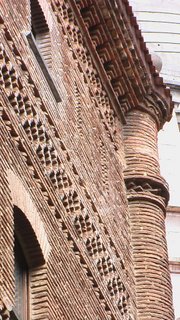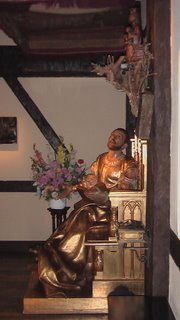 For those who do not know the life of Ignatius of Loyola like the back of their hand, Azpeitia is the town near the Loyola estate. It seems that the Loyolas used to have a kind of stone fort, but when Grandpa Loyola and the other local dons (no kidding) were putting pressure on the townspeople to continue the feudal ways, the townspeople, intent on a form of self-governing, appealed to the King (I don't know which King; had Ferdinand and Isabella unified Spain by then?). The upshot was that the King sided with the little people, exiled their Lordships to the frontier by the Moors, and had the fortresses torn down. The ruling class had abused their power, and were no longer permitted to have fortresses or castles. They could only build in brick.
For those who do not know the life of Ignatius of Loyola like the back of their hand, Azpeitia is the town near the Loyola estate. It seems that the Loyolas used to have a kind of stone fort, but when Grandpa Loyola and the other local dons (no kidding) were putting pressure on the townspeople to continue the feudal ways, the townspeople, intent on a form of self-governing, appealed to the King (I don't know which King; had Ferdinand and Isabella unified Spain by then?). The upshot was that the King sided with the little people, exiled their Lordships to the frontier by the Moors, and had the fortresses torn down. The ruling class had abused their power, and were no longer permitted to have fortresses or castles. They could only build in brick.So when Grandpa Loyola was allowed back to his torn-down fort, of which only the central tower remained--and only two stories of it, at that (and the ground floor of these things was always the stable), he got Moorish brickworkers in to raise the tower back to a decent height, and with a bit of class. It was in that tower-house that Ignatius was born, and although he left home very young (14 or so); it was to this house that he was carried back from battle, seriously wounded; it was in this house that he was converted to the Lord.
This was the goal of our trip: the "holy house" of Loyola--though, to look at it, you wouldn't know there was a tower or a house there. Those enterprising Jesuits built a basilica around it.
Even during Ignatius' lifetime, the first Companions revered the place where his spiritual j
 ourney had begun. It was here that Ignatius first perceived the movements of his inner spirit, leading him to eventually formulate the whole concept of discernment. It was from here that Ignatius (still Iñigo) set out to imitate the saints.
ourney had begun. It was here that Ignatius first perceived the movements of his inner spirit, leading him to eventually formulate the whole concept of discernment. It was from here that Ignatius (still Iñigo) set out to imitate the saints.Finally, Karen and I had arrived. The credit cards were still a problem when we pulled up to the little Hotel Loiola, just down the road (literally, maybe a quarter of a mile) from the twoer-house and its circumscribing Basilica. My community had provided me with something for an emergency, and this qualified (we were, as I wrote before, in the middle of absolutely nowhere), so soon Pedro was on his way back to Navarre, while Karen and I lugged our bags to our rooms. (No helpfulness there--Karen thought the proprietor was a bit surly, but later we learned that the family may have just been embarrassed: people here do not necessarily speak Castillian, just the local language which is the oddest accumulation of sounds and syntax known to man.) After getting situated, we walked that quarter mile to the shrine.
It seems it had been a relative of St. Francis Xavier who had transported the wounded soldier here from Pamplona. It was hard enough getting here by car; it couldn't have been an easy matter on a litter! We made a quick run through the tower-house, lest a Manresa happen to us. (Does that sound paranoid?) The "conversion room" was the highlight of the whole trip for me. Not only was this the place where Iñigo recovered from his war wounds (and then from the barbarous surgery he underwent without any kind of anaesthesia), it was where he succumbed to the influence of grace. A somewhat tattered canopy hangs from the ceiling (you can see it a bit in the photo); the evidence indicates that this was the canopy that hung over the patient's bed! And right there is a life-sized statue of a very well dressed young man of the Renaissance, seated on a bench, book in hand--with one foot resting on a stool. He is looking up rapturously, toward a tiny statue of Mary that is perched on a rough-hewn column.
More about that in my next installment!

1 comment:
I'm "homesick" for Azpeitia from reading that.
I believe it was Alfonso the whatever-th who ran Grandpa out of town, but I could be wrong. I would surely know if anything would stick in my brain longer than 3 seconds, because I've read that story about 25 times this week!
Post a Comment